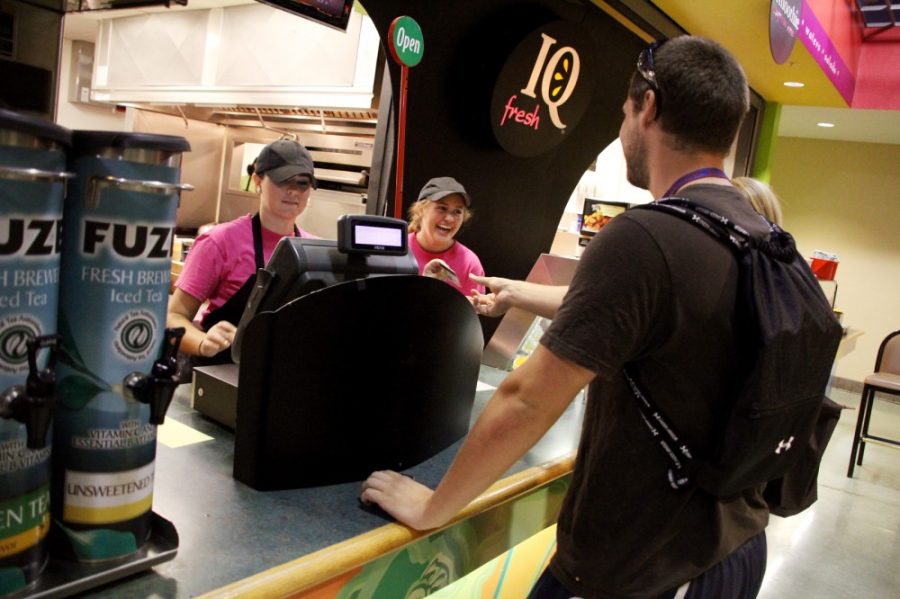With more than 35 campus restaurants to choose from, and more in the works, no student’s eating routine should be mundane.
However, it doesn’t seem to be lack of options that students’ are displeased with, but rather the availability of healthy options, and for some, more affordable ones.
For Rebecca Zayon, a marketing senior, healthiness is a greater factor than price when it comes to food. Zayon also emphasized the lack of healthy choices on campus.
“Where, besides Core, can you get a good salad?” Zayon asked.
In response to students’ concerns with healthy eating, Nicolas Adamakis, director of marketing for Student Affairs and assistant director of Arizona Student Unions, mentioned the newly added “healthy options” link on the union’s website. The link on each menu will show students the five healthiest options available to them.
“And we plan to roll out next spring a fully functional, interactive site where students can easily select any menu item being served in our restaurants and get complete nutritional information, online through the Arizona Mobile (smartphone application),” Adamakis said.
For David Shapiro, a senior studying retailing and consumer sciences, the speed of service and health of the food are his two biggest factors when choosing where to eat on campus.
“The only place that’s healthy and semi-quick is IQ Fresh, but that can get really hectic,” Shapiro said. “The healthy options on campus are not even close to being competitive with the unhealthy options.”
Although some students feel there is a lack of healthy, affordable eating on campus, Adamakis said he is focused on meeting students’ needs.
“Our students are very aware of their food choices and are making better decisions about what they consume, so we always have to be more responsive to their needs, as our menus grow and are refreshed. It is a priority for us to have more healthy options available,” he said.
Adamakis also pointed out that students who purchase one of the meal plans receive a financial boost since every meal they purchase is exempt from the state sales tax.
However, for those clipping coupons and counting pennies, healthier options can sometimes still stand on the pricey end of the spectrum. In particular, Shapiro said the food marts on campus are over priced.
“A lot of freshmen can’t drive to Safeway and their only option is to pay $8 for a box of cereal,” he said.
James Clark, a creative writing senior, said he likes Panda Express because it’s cheap and you get a lot of food.
Jillian Mackillop, a junior studying English and psychology, said the price of restaurants influences her decision more than health, and she often chooses fast food like Burger King because healthier options are too expensive. Mackillop also mentioned that there aren’t enough cheaper options on campus.
“A lot of people do like fast food, and having it on campus encourages people to eat it when there aren’t a lot of other affordable options,” Zayon said. “When it comes down to it, a lot of us are broke college students — the less money to spend on food the better, but that means more people will be eating fast food.”
Despite some students’ complaints about pricing, restaurants like Core maintain their popularity.
According to Leigh Ann Cionni, Core student lead, the restaurant has several returning customers and the extra charges on proteins don’t make them any less popular among students.
Sarah Lupo, a junior studying English, said she takes advantage of deals at restaurants like Core, but mostly sticks to the U-Mart and tries to avoid buying full meals on campus.
The UA plans to open a Pinkberry Frozen Yogurt later this winter as well as a bagel shop similar to the concept of Einstein Bros Bagels to add to students’ options, Adamakis said. The newly opened La Petite Patisserie in the Park Student Union is popular for breakfast, lunch and late night snacks, according to Daniel Dobkowski, supervisor for Dining Services. The restaurant’s crepe batter is made fresh daily, and baked goods are brought every morning from the union’s bakery.
“As far as our decision-making process goes, our goal when choosing new restaurants is to fill a niche in local dining options and give students places to eat that are on par, or better than, off-campus locations,” Adamakis said. “It’s also important that we give students an overall experience at the union, or our other locations, that will keep them coming back again and again.”









